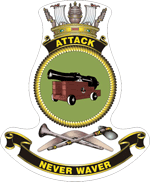HMAS Acute was an Attack-class patrol boat operated by the Royal Australian Navy (RAN).

HMAS Adroit was an Attack-class patrol boat of the Royal Australian Navy (RAN).
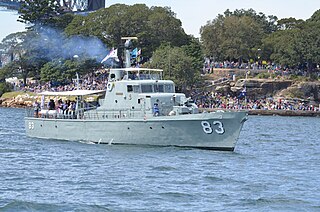
HMAS Advance was an Attack-class patrol boat of the Royal Australian Navy (RAN). Constructed during 1967 and commissioned into the RAN in 1968, Advance operated from Darwin and patrolled northern Australian waters.
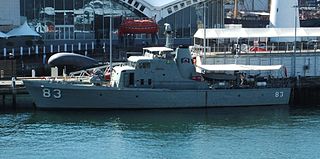
HMAS Aitape was an Attack-class patrol boat of the Royal Australian Navy (RAN). It was named for the small town of Aitape, Sandaun Province, Papua New Guinea. Completed in 1967, the vessel was one of five assigned to the RAN's Papua New Guinea (PNG) Division. The patrol boat was transferred to the Papua New Guinea Defence Force in 1974 as HMPNGS Aitape. She remained active until 1982, when she was removed from service for use as a parts hulk. Aitape was scuttled off Port Moresby for use as a dive wreck in 1995.
HMAS Archer was an Attack-class patrol boat of the Royal Australian Navy (RAN).

HMAS Ardent was an Attack-class patrol boat of the Royal Australian Navy (RAN). She was built by Evans Deakin and Company, and was commissioned into the RAN in 1968. Ardent was decommissioned in 1994, then assigned as a navigation training vessel. At the end of 1998, she was removed from service. Initially marked for preservation at the Darwin Military Museum, the vessel was sold into civilian service in 2001 after the Northern Territory government declined. In 2002, the patrol boat was acquired by the Indonesian Navy, and commissioned as KRI Tenggiri (865) in 2003.

HMAS Arrow was an Attack-class patrol boat of the Royal Australian Navy (RAN).

HMAS Assail was an Attack-class patrol boat of the Royal Australian Navy (RAN).
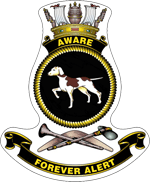
HMAS Aware was an Attack-class patrol boat of the Royal Australian Navy (RAN).
HMAS Bandolier was an Attack-class patrol boat of the Royal Australian Navy (RAN).
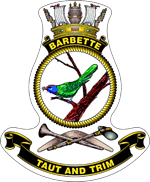
HMAS Barbette was an Attack-class patrol boat of the Royal Australian Navy (RAN).
HMAS Barricade was an Attack-class patrol boat of the Royal Australian Navy (RAN).

HMAS Bayonet was an Attack-class patrol boat of the Royal Australian Navy (RAN).
HMAS Bombard was an Attack-class patrol boat of the Royal Australian Navy (RAN).
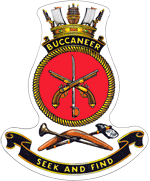
HMAS Buccaneer was an Attack-class patrol boat of the Royal Australian Navy (RAN).

HMAS Ladava was an Attack-class patrol boat of the Royal Australian Navy (RAN). It was named after the small village of Ladava situated on the shore of Milne Bay in Alotau District, Papua New Guinea. Completed in 1968, the vessel was one of five assigned to the RAN's Papua New Guinea (PNG) Division. The patrol boat was transferred to the Papua New Guinea Defence Force in 1974 as HMPNGS Ladava. The patrol boat was decommissioned in 1988, although her fate is unknown.

HMAS Madang, named for the settlement of Madang in New Guinea, was an Attack-class patrol boat of the Royal Australian Navy (RAN). Completed in 1968, the vessel was one of five assigned to the RAN's Papua New Guinea (PNG) Division. The patrol boat was transferred to the Papua New Guinea Defence Force in 1974 as HMPNGS Madang. She was decommissioned in 1989.

HMAS Samarai, named after the island of Samarai and its former town, was an Attack-class patrol boat of the Royal Australian Navy (RAN). Completed in 1968, the vessel was one of five assigned to the RAN's Papua New Guinea (PNG) Division. The patrol boat was transferred to the Papua New Guinea Defence Force in 1974 as HMPNGS Samarai. She remained in service until 1987, when she was paid off and used as a parts hulk.

HMAS Lae was an Attack-class patrol boat of the Royal Australian Navy (RAN). It was named for the city of Lae, capital of Morobe Province, Papua New Guinea. Completed in 1968, the vessel was one of five assigned to the RAN's Papua New Guinea (PNG) Division. The patrol boat was transferred to the Papua New Guinea Defence Force in 1974 as HMPNGS Lae. She remained in service until 1988.

The Fremantle-class patrol boats were coastal patrol vessels operated by the Royal Australian Navy (RAN) from 1979 to 2007. Designed by British shipbuilder Brooke Marine and constructed in Australia by North Queensland Engineers and Agents, the Fremantle class were larger, more powerful, and more capable than the preceding Attack class, and the two primary patrol boat bases required infrastructure upgrades to support them. Although up to 30 vessels were planned, fifteen were ordered and constructed, with an unexercised option for five more.

